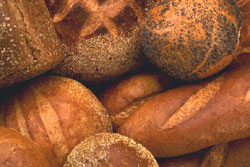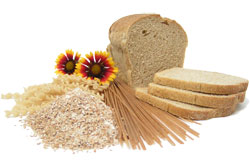- What is a gluten free diet?
- Who follows a gluten free diet?
- How does a gluten free diet work?
- What is eaten in a gluten free diet?
- How much can be eaten in a gluten free diet?
- Health benefits of a gluten free diet
- Limitations of a gluten free diet
- Tips for changing to a gluten free diet
What is a gluten free diet?
A gluten free diet, as the name suggests, is a diet free of gluten. Gluten is a storage protein derived from wheat, barley, rye and a number of other cereals, and thus is commonly found in modern diets. Each of these cereals has a specific glutenous protein:
- Wheat (including kamut and spelt): Contains gliadins
- Barley: Contains hordiens
- Rye: Contains secalins
In order to keep gluten out of your diet, you must exclude not only these cereal foods, but also manufactured foods and products that have even a small amount of gluten.
Who follows a gluten free diet?
A gluten free diet is typically followed by people with an intolerance to gluten for medical purposes. These include people with dermatitis herpetiformis or coeliac disease. A gluten free diet is the only effective treatment for gluten intolerance, and must be strictly followed for life.
Gluten free diets are also used to diagnose gluten intolerance when the condition is suspected. After prescribing a gluten free diet, a health professional will monitor your response to the diet. If the symptoms of gluten intolerance diminish while adhering to the diet, gluten intolerance can be diagnosed.
How does a gluten free diet work?
A gluten-free diet manages gluten intolerance by removing the toxic agent (i.e. gluten) from the diet (and the intolerant individual’s digestive system) and subsequently reduces the small intestine’s inflammatory response to gluten.
What is not eaten on a gluten free diet?

- Barley
- Barley malt/extract
- Bran
- Bulgur
- Couscous
- Durum
- Einkorn
- Emmer
- Farina
- Faro
- Graham flour
- Kamut
- Matzo flour/meal
- Orzo
- Panko
- Rye
- Seitan
- Semolina
- Spelt
- Triticale
- Udon
- Wheat
- Wheat bran
- Wheat germ
- Wheat starch
Consumption of oats also results in symptoms of gluten-intolerance in some 5% of individuals, however there is controversy about the reasons for this. Some believe that oats themselves do not contain glutens, rather, they become contaminated with small amounts of gluten in the manufacturing process. Others believe that oats themselves are a source of glutens (specifically of proteins called avidins).
In countries such as Australia, where wheat is a key staple food, avoiding the above listed cereals means avoiding a wide range of manufactured foods which include these gluten-containing cereals. Some of the key foods which must be avoided include:
- Breads
- Pasta
- Packet soups, gravy and other artificial thickeners
- Beer
- Processed meats
- Communion wafers
- Many sauces
It is also necessary for individuals following a gluten free diet to approach with caution, many manufactured foods or other products which may contain hidden sources of gluten. These include:
- Hydrolysed vegetable protein;
- Modified food starch;
- Malt or malt flavouring;
- Vegetable gum;
- Natural flavourings;
- Some medications;
- Lipsticks;
- Grain derived alcoholic beverages.
Individuals who are intolerant to gluten should also be aware of the ease with which foods that do not contain gluten can become gluten contaminated. For example oats, a supposedly non gluten containing cereal often cause allergic reactions in gluten intolerant individuals. Research suggests that this is due to cross-contamination in the harvest and manufacture process. Oats may be mixed with small quantities of wheat during harvesting, or be exposed to wheat derived products (e.g. flour on a conveyor belt to stop foods sticking). It may therefore be necessary to purchase foods manufactured by a company dedicated to ensuring their produce is gluten-free.
What is eaten on a gluten free diet?
While a gluten-free diet excludes a wide range of foods based on their cereal contents, there are also a wide range of foods which can be eaten, and many substitute products which do not contain gluten are now available. Followers of the diet can eat a wide variety of foods, particularly fresh foods, including all types of fruits, vegetables and meat. Most dairy products are also safe, including milk, yoghurt, cheese (except processed cheese), butter and margarine.
The following foods can also be eaten, or used in cooking, as substitutes for foods which contains gluten:
- Gluten free bread and pasta: a number of manufacturers now produce gluten-free bread and pasta;
- Rice and rice noodles or crackers;
- Corn and corn bread;
- Potatoes, potato flour and potato starch;
- Flours made from nuts, beans and seeds;
- Tapioca;
- Buckwheat.
In addition to ensuring all sources of gluten are eliminated from the diet, individuals following a gluten free diet may need to pay particular attention to ensuring that they consume enough proteins and micronutrients to ensure their system is healthy. In particular individuals with newly-diagnosed gluten-intolerance may be deficient in iron, folate, calcium and Vitamin D, as the intestinal symptoms associated with the condition reduce the absorption of these micronutrients. This is particularly true if the individual has co-existing eating requirements (e.g. due to diabetes, vegetarianism).
How much can be eaten on a gluten free diet?
Individuals following a gluten free diet should aim to eat a well balanced and nutritious diet, while excluding gluten. Individuals who need to follow a gluten-free diet will probably be referred to a dietitian to develop an eating plan that meets their nutritional requirements. Local support groups for gluten intolerant individuals are also a good source of information regarding diet options. Gluten free diets tend to be low in fibre, so particular attention should be given to ensuring adequate fibre in the diet, through the consumption of whole grain rice, maize, potatoes and fresh vegetables.
Health benefits of a gluten free diet

Limitations of a gluten free diet
While gluten-free diets are an effective treatment for coeliac disease and dermatitis herpetiformis, they are only effective when adhered to. Thus, a gluten free diet must be strictly followed for life. This can be difficult, because many staple foods are excluded, but also because a wide range of manufactured foods contain gluten in small quantities. Essentially this means that individuals following the diet must carefully read the packaging of all manufactured foods to ensure they are gluten free.
Tips for changing to a gluten free diet
Individuals who require a gluten free diet should be advised to:
- Plan the diet with the help of a professional trained in gluten free diets, to ensure that it is not only gluten-free, but contains sufficient quantities of nutrients to keep their body healthy;
- When attempting to identify manufactured foods which can be consumed, check the labels on the food already in the cupboard, to see whether or not they are gluten free. This is much easier than starting at the supermarket;
- Take care not to contaminate gluten free foods, when preparing them. For example contamination can occur by using the same knife to butter gluten free and containing breads, or the same toaster to toast such breads.
More information
 |
For more information on nutrition, including information on types and composition of food, nutrition and people, conditions related to nutrition, and diets and recipes, as well as some useful videos and tools, see Nutrition. |
References
- Gluten-free diet guide for families [online]. Flourtown, PA: Children’s Digestive Health and Nutrition Foundation; 2005 [cited 18 February 2009]. Available from: URL link
- Murray JA. The widening spectrum of celiac disease. Am J Clin Nutr. 1999;69(3):354-65. [Abstract | Full text]
- Bai J, Zeballos E, Fried M, et al. Practice guideline: Celiac disease [online]. Milwaukee, WI: World Gastroenterology Organisation; 2007 [cited 18 February 2009]. Available from: URL link
- Pagano AE. The gluten-free vegetarian. Pract Gastroenterol. 2007;31(5):94-102. [Full text]
- Kupper C, Higgins LA. Combining diabetes and gluten-free dietary management guidelines. Pract Gastroenterol. 2007;31(3):68-80. [Full text]
All content and media on the HealthEngine Blog is created and published online for informational purposes only. It is not intended to be a substitute for professional medical advice and should not be relied on as health or personal advice. Always seek the guidance of your doctor or other qualified health professional with any questions you may have regarding your health or a medical condition. Never disregard the advice of a medical professional, or delay in seeking it because of something you have read on this Website. If you think you may have a medical emergency, call your doctor, go to the nearest hospital emergency department, or call the emergency services immediately.








